Riverboat Accident
Published 07/14/08
Photos contributed by
Gary Richardson
Please note the following story was written by
Dean White.
This text for this story was found at
Littleriverbooks.com
|
On April 28, 1979,
a ferry boat named the Cahaba intended to cross the Rooster
Bridge on the Tombigbee River in Alabama.
However when the
bridge did not raise for the boat, the Cahaba resorted to
alternative methods.
This is a recount of the story.
|
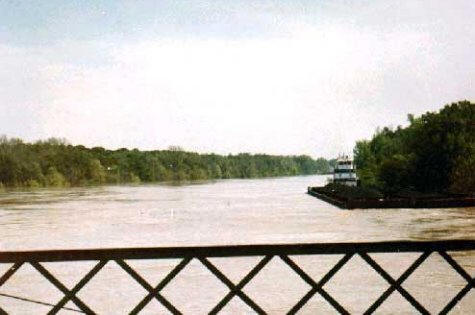 |
"I was working at Warrior & Gulf
Navigation at the time as a pilot, and was actually
downstream 40-50 miles from the Rooster Bridge when the
incident occurred.
River conditions were extremely bad that spring; one of the
highest rises on the Tombigbee. Current was so swift around
the bridges that we were "double-tripping" four barge tows
(two at a time).
|
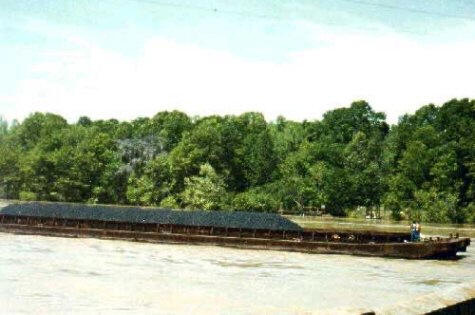 |
At this
particular bridge, (the Rooster, so named because it was
paid for in part by the sale of a certain breed of rooster
that was highly prized; Woodrow Wilson and Clemenceau of
France are listed as buyers), we practiced what we call
“dropping 'em through" the east span. We pointed the barges
under the east span of the bridge, where the current was
less severe, cutting them loose from the boat, then running
the boat through the lift span, and catching them back below
the bridge.
|
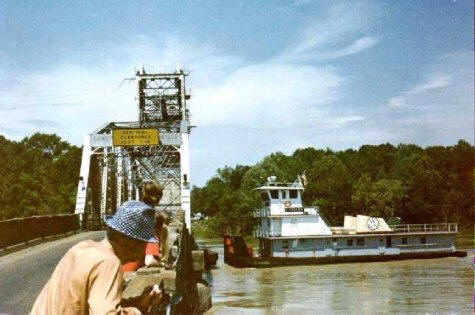 |
This was
Capt. Jimmy Wilkerson’s intent; this was why the first
picture shows him so close to the east span. He had his two
deckhands and Pilot Earl Barnhardt out on the tow to remove
all rigging, and throw the winch wires off. Unfortunately,
for some reason, they had neglected to take the starboard
tow-knee wire off, and this was what pulled him into the
bridge structure.
|
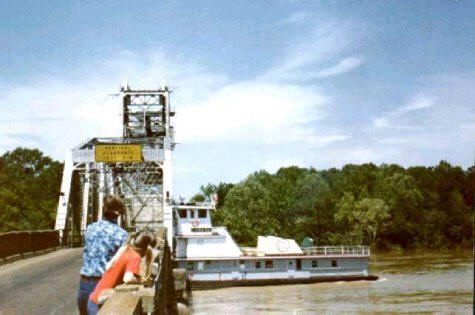 |
You can
see that the starboard tow-knee catches under the steel of
the bridge; the wire was attached to the timberhead of the
stern barge, and it pulled the boat into a starboard list.
When the tow-knee struck the bridge, the wire broke, and the
top of the knee came up and hung in the bridge steel.
|
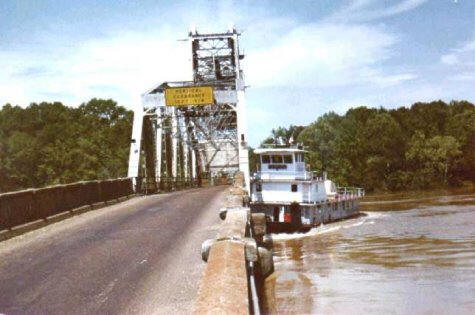 |
At that
point, the raging current took over, and laid the Cahaba,
starboard side to, against the bridge. Once the port lower
deck went awash, there was no chance for recovery. Capt.
Wilkerson, in effect, took a 37-foot tall towboat, and put
it through a 11-foot span.
|
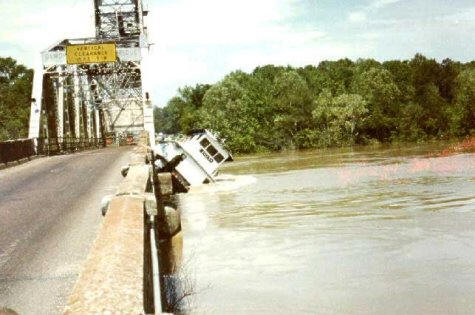 |
The photos
were taken by a reporter from the “Linden (Ala.) Democrat,”
a nearby small-town newspaper. This person was en route to
Meridian, Miss., that morning and happened to arrive at the
bridge, along with several other witnesses, while the main
span was lifted to let the Cahaba pass. He had no idea what
he was about to witness; he did, however, have the foresight
to keep snapping as the event unfolded.
|
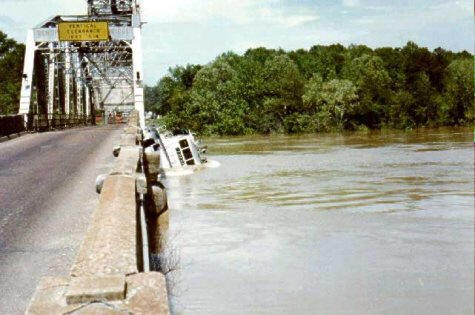 |
When Capt.
Wilkerson saw he was not going to recover the vessel, he
yelled into his loudspeaker, “All right, y'all, this ain't
no fire drill. Get off the damn bridge!” Once the boat laid
over and went under the bridge, those watching thought for
sure it was sunk, and all aboard gone with it. They were all
relieved to see the Cahaba right itself, with Capt.
Wilkerson still at the controls.
|
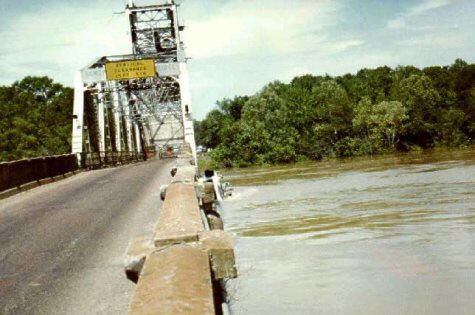 |
One of the
two Detroit 16-149s was still running; the port one had
flooded out. Capt. Wilkerson said, at one point, he was
straddled across the port wheelhouse door, when the front
window popped out, and the wheelhouse filled with water.
|
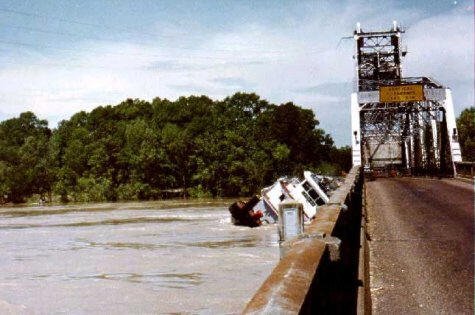 |
The Mv.
Tallapoosa was just downstream from the bridge when the
incident occurred; Capt. Gary Grammer got word from the Mv.
Cathy Parker, waiting above the bridge for her turn, that
something had happened to the Cahaba.
|
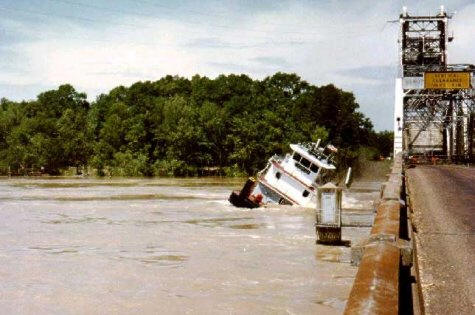 |
Capt.
Grammer tied off his tow, and raced upstream as best he
could to assist. The Tallapoosa caught the Cahaba a ways
below the bridge, and shoved her out into a flooded corn
field. The barges were then caught, and the three crew
members on them rescued.
|
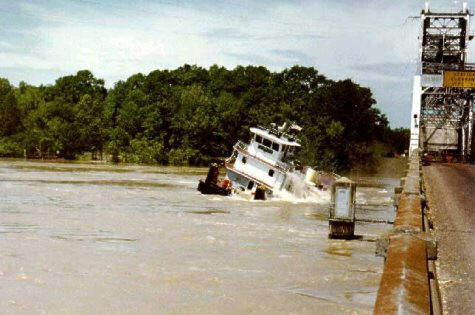 |
What made
the Cahaba miraculously recover and right itself?
Main
reason: the vessel had just topped off with fuel at
Demopolis, Ala., just 13 miles north of where the accident
happened. Therefore, the fuel tank was full. There was no
shifting of weight as the vessel laid over.
|
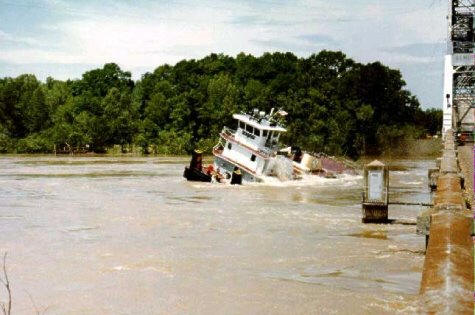 |
It was
somewhat akin to those punching bags from years gone by;
when you knocked them down they just righted themselves
again. Had she only been half full of fuel, she probably
would have never come back upright.
|
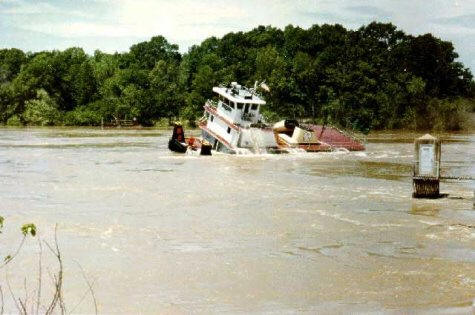 |
The reason
these pictures stayed out of circulation for so long?
Speculation is that the president of Warrior & Gulf bought
the negatives immediately after they were published in the
“Linden Democrat.” I have a copy of the original paper they
were printed in; it is now old, yellow and crumbling. We all
thought that they would wind up in “The Waterways Journal,”
and were a bit surprised when they didn't; but I believe Mr.
Nick Barchie had something to do with that.
|
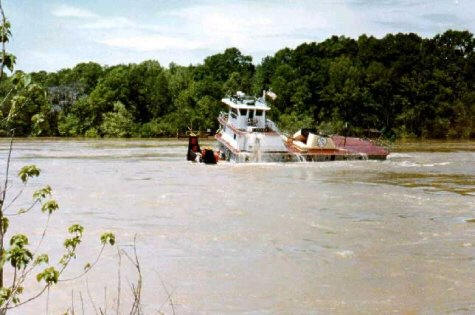 |
Several years
later, the Rooster Bridge was replaced with a high rise a
few miles north, and the original bridge was taken out, much
to the relief of all of us who navigated the Tombigbee.”
Please note -
story accompanying pictures written by:
Dean White
Marine Superintendent
Mv. DELTA MARINER
|
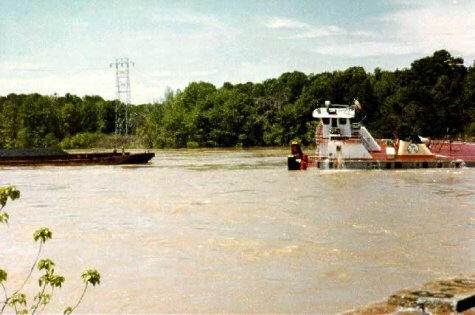 |
|
|